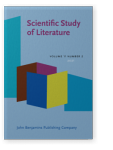Vol. 11:2 (2021) ► pp.266–282
Exploring the dimensional relationships of story world absorption
A commentary on the role of attention during absorbed reading
Absorption has proven to be an important mediator of reading enjoyment and persuasive text effects (Green & Brock, 2000; Kuijpers et al., 2014). Typically, absorbing experiences with narrative media are captured using self-report measuring instruments. One such instrument is the Story World Absorption Scale, which is comprised of four dimensions: Attention, Emotional Engagement, Mental Imagery, and Transportation (Kuijpers et al., 2014). As of yet, we do not know how these dimensions relate to one another. Data from four different studies (one survey and three experiments) using the Story World Absorption Scale were investigated with the use of structural equation modeling to attempt to answer this question. The results show that attention fulfills a crucial role in the absorption experience confirming the work of Kuiken and Douglas (2017, 2018) on absorption-like states. The findings inspire a discussion on how we (should) use multi-dimensional instruments in the field of empirical literary studies.
Article outline
- Introduction
- Dimensions of narrative absorption
- The present research
- Method
- Sample characteristics
- Measures
- Data analyses
- Results
- Hypothesis 1
- Hypothesis 2
- General discussion
- The role of attention in absorption
- Reconceptualization of the story world absorption construct
- Future research
- Acknowledgements
-
References
